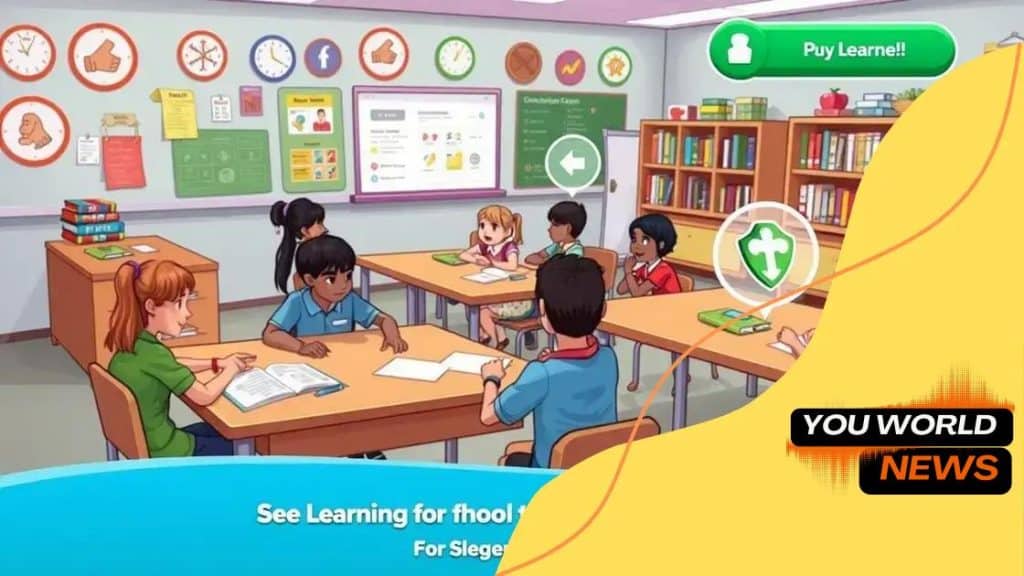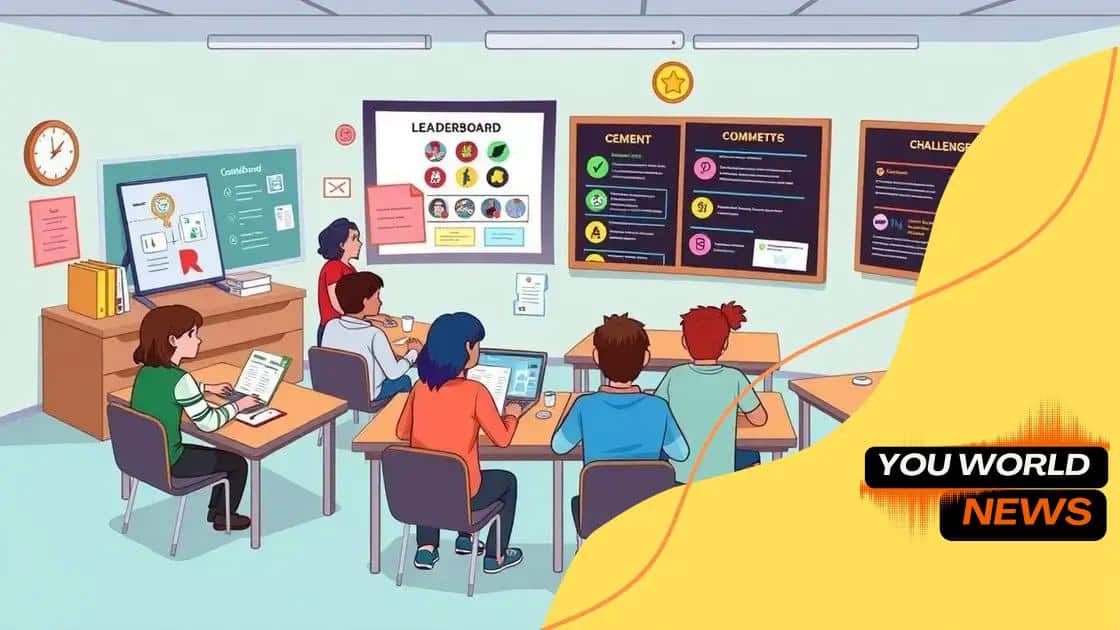Gamification techniques for improving student motivation

Gamification techniques enhance student motivation by integrating game elements like points, badges, and challenges into the learning process, resulting in increased engagement, retention, and overall improved educational outcomes.
Gamification techniques for improving student motivation are reshaping educational landscapes. Have you ever wondered how game elements can make learning more engaging and fun? Let’s dive into this exciting approach.
Understanding gamification and its principles
Understanding gamification means looking at how game elements can be combined with education. It’s fascinating how simple principles from games can transform learning into something engaging. By using game mechanics in the classroom, teachers can motivate students in many positive ways.
What is Gamification?
Gamification involves applying aspects of gameplay, like scoring points and unlocking achievements, to non-game environments. This method helps to make learning more dynamic and enjoyable. For example, when students earn points for completing assignments, it can encourage them to engage more with the material.
Key Principles of Gamification
There are several key principles that drive successful gamification in education. Understanding these can help educators apply them effectively:
- Challenge: Providing tasks that are difficult yet achievable keeps students engaged.
- Feedback: Regular feedback helps learners understand their progress and areas for improvement.
- Rewards: Recognizing achievements boosts motivation and encourages continued effort.
- Collaboration: Encouraging teamwork fosters a sense of community and shared success among students.
Incorporating these principles into lessons can lead to a more interactive learning experience. Gamification changes the way students view their education. Instead of seeing learning as a chore, they begin to view it as an adventure. This shift can be powerful in fostering a lifelong love for learning.
One key aspect of gamification is the idea of progress tracking. Students can see how far they’ve come, which provides a sense of accomplishment. Regularly updating progress charts can motivate students to push further. This is similar to leveling up in a game, where each milestone achieved opens new possibilities for growth.
Benefits of Gamification
The benefits of employing gamification techniques in the classroom include improved engagement, higher motivation levels, and better retention of information. When learners are motivated, they are more likely to participate actively. This leads to a deeper understanding of subjects.
Additionally, gamification helps meet different learning styles. Some students might thrive on competition, while others may prefer collaborative tasks. By mixing elements, teachers can cater to various preferences, ensuring every student finds something that resonates.
How gamification enhances student engagement
How gamification enhances student engagement is a crucial topic for educators. By incorporating game-like elements into learning, teachers can create a more vibrant classroom atmosphere. This approach helps students feel excited about their studies, making learning feel less like a chore.
Motivation Through Fun
Gamification introduces fun into education. When learning feels like play, students are more likely to participate actively. A classroom filled with engaging activities encourages students to explore subjects deeply. For instance, using interactive quizzes can transform basic reviews into competitions, where students race against each other to answer correctly.
Personalized Learning Experiences
Another exciting aspect of gamification is that it allows for personal learning journeys. Students often have different interests and speed of learning. Through gamified elements, educators can create tasks tailored to individual strengths. This level of customization helps keep students engaged, as they can work at their own pace.
- Choice: Allowing students to choose their challenges increases ownership.
- Achievements: Recognizing accomplishments builds confidence.
- Levels: Progressing through levels can make learning feel like an adventure.
Additionally, gamification fosters collaboration among students. Group activities can encourage teamwork, where learners support and motivate each other. This shared experience not only enhances engagement but also builds social skills that are crucial for future success.
Engagement also occurs when students see the relevance of what they are learning. Gamification can bridge the gap between academic content and real-world applications. For example, through simulations that mimic real-life scenarios, students can practice skills that prepare them for future careers.
Feedback and Progress Tracking
Instant feedback is another powerful feature of gamification. It helps students understand their progress immediately. This real-time response motivates them to improve continually. When students receive recognition for their efforts, even in small ways, they remain engaged and excited about learning.
Overall, gamification enhances student engagement dramatically. By merging educational content with game mechanics, learning transforms into a more interactive and enjoyable experience. This shift in approach can lead to deeper understanding and retention of knowledge.
Key gamification techniques for the classroom

Understanding key gamification techniques for the classroom can significantly enhance student participation. Educators can transform standard lessons into exciting challenges that keep learners engaged. Utilizing these techniques not only makes learning fun but also fosters a deeper connection to educational content.
1. Points and Levels
A common technique involves assigning points for completing tasks. As students earn points, they can progress through levels. This system provides a clear sense of achievement. Each level can introduce new challenges that increase in difficulty, keeping students motivated.
2. Badges and Achievements
Creating badges for specific accomplishments is another effective method. When students complete particular assignments or reach milestones, they receive badges as recognition. This visual representation of success encourages healthy competition among peers and boosts self-esteem.
- Encourages participation: Students are more likely to engage actively in learning.
- Builds motivation: The desire to earn badges inspires learners to excel.
- Fosters a sense of community: Sharing achievements promotes positive interaction.
3. Leaderboards can create friendly competition among students. By displaying scores publicly, students are encouraged to improve and strive for higher rankings. This technique taps into the competitive spirit, driving engagement as learners aim to outdo each other.
4. Challenges and Quests
Incorporating challenges or quests into the curriculum can make learning more dynamic. Students could work individually or in teams to complete tasks that require creativity and collaboration. This method not only makes learning fun but also develops critical thinking and problem-solving skills.
Furthermore, using storytelling elements can enhance gamification. By creating a narrative around lessons, educators can make subjects more relatable. This can help students connect emotionally with the material, ensuring better retention and understanding.
Lastly, incorporating immediate feedback is crucial in enhancing gamification in the classroom. When students receive feedback right after completing a task, they can identify areas for improvement promptly. This contributes to an ongoing learning process, ensuring they stay on track.
Real-world examples of gamification success
Exploring real-world examples of gamification success reveals how effective this approach can be in various fields. Many companies and educational institutions have adopted gamification techniques to achieve significant improvements in engagement and motivation.
1. Duolingo
Duolingo is a popular language-learning app that uses gamification to teach users. Through a point system, levels, and achievements, learners feel motivated to practice regularly. The app rewards users with lingots and badges as they progress. This creates a fun environment that encourages users to continue their learning journey.
2. Khan Academy
Khan Academy is another great example. This educational platform incorporates gamified elements to enhance student learning. Students earn points and badges for completing tasks and mastering concepts. This method of recognizing achievements helps keep learners engaged and motivated. The immediate feedback system also guides them through their educational roadmaps.
- Interactive lessons: Engaging content keeps students interested.
- Goal setting: Encourages learners to aim for higher achievements.
- Social sharing: Students can share successes, increasing motivation.
3. Microsoft’s Language Quality Game is an innovative use of gamification in a corporate environment. Employees compete to improve translations in software, earning rewards and recognition. This not only helps improve the quality of work but also fosters teamwork and motivation among colleagues.
4. Audi’s gamification of the customer experience enhances engagement during car shopping. The fun, interactive features on their website allow customers to customize cars and earn rewards. This approach creates an enjoyable buying process and keeps customers interested in their products.
5. Fitbit
Fitbit takes gamification into personal fitness. The device tracks users’ activities and rewards them with badges for reaching fitness goals. Users can challenge friends, creating a sense of competition that pushes them to be more active. This community aspect significantly enhances motivation and engagement with health and fitness.
These examples highlight the power of gamification in both educational and commercial contexts. By integrating game-like elements, organizations can increase engagement, motivation, and satisfaction among users. The approach fosters a more compelling and interactive experience, making achievements feel more rewarding.
Measuring the impact of gamification on learning
Measuring the impact of gamification on learning is essential to understand its effectiveness. Educators and researchers strive to identify how gamified elements influence student engagement, retention, and performance. Various methods can assess these impacts effectively.
1. Student Feedback
One simple yet powerful way to gauge the impact is through student feedback. Surveys and interviews can provide insights into students’ feelings about gamified learning experiences. Understanding their perspectives helps educators refine their approaches.
2. Performance Metrics
Analyzing performance metrics can also reveal the effectiveness of gamification. Teachers can compare grades, test scores, and assignment completion rates before and after implementing gamified strategies. Improvements in these areas often indicate a positive impact.
- Increased engagement: Higher participation rates suggest that gamification successfully captures student interest.
- Improved retention: Students recalling information better post-gamification indicates effective learning.
- Achievement milestones: Tracking the number of badges or levels achieved offers insights into motivation.
3. Observational Studies are another method to measure the impact. Educators can observe classroom dynamics during gamified lessons. Noticing increased collaboration, communication, and enthusiasm among students can highlight the positive effects of gamification.
4. Longitudinal Studies
Longitudinal studies take a broader view. Researchers can track groups of students over time to assess long-term retention of knowledge and skills. This method reveals how deeply gamification impacts learning outcomes beyond the immediate effects.
Finally, integrating technology can enhance measurement. Learning management systems (LMS) often provide analytics that show engagement levels, time spent on tasks, and completion rates. These data can paint a comprehensive picture of how gamification works in practice.
Understanding the impact of gamification on learning helps educators develop effective strategies. By evaluating various metrics, teachers can enhance their methods, ensuring students benefit from engaging and effective learning experiences.
FAQ – Frequently Asked Questions about Gamification in Education
What is gamification?
Gamification is the integration of game elements, like points and rewards, into non-game contexts to enhance engagement and motivation.
How does gamification improve student learning?
Gamification keeps students engaged by making learning enjoyable, promoting active participation, and aiding information retention.
What are some examples of successful gamification?
Successful examples include apps like Duolingo and educational platforms like Khan Academy, which use points, badges, and challenges to motivate learners.
How can the impact of gamification be measured?
The impact can be measured through student feedback, performance metrics like grades, and observational studies during gamified lessons.





